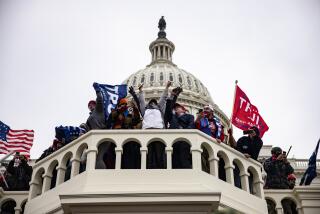One-sided talk on gun control
- Share via
WASHINGTON — Monday’s deadly rampage at Virginia Tech sparked a largely one-sided response in the long-running debate over guns.
Gun control advocates said the shootings pointed to the need for tougher laws, while supporters of gun rights generally kept their heads down.
And leaders of both major political parties expressed sympathy for victims and their families, while avoiding comment on gun control.
In brief remarks from the White House, President Bush expressed the nation’s grief over the carnage in Blacksburg, Va. “Schools should be places of sanctuary and learning,” he said. “When that sanctuary is violated, the impact is felt in every American classroom and every American community.”
Bush, a longtime champion of the right to bear arms, said nothing about the gun control debate.
Similarly, Senate Majority Leader Harry Reid of Nevada and House Speaker Nancy Pelosi of San Francisco expressed sorrow about the shootings but remained silent on gun control. In the past, Democrats often have led the fight for tighter gun laws, but recently the party has been trying to broaden its appeal to hunters and others who oppose more controls.
However, Rep. Carolyn McCarthy (D-N.Y), whose husband was among six people killed by a gunman who opened fire on a Long Island Rail Road train in 1993, added a political note to her statement of sympathy. “The unfortunate situation in Virginia could have been avoided if congressional leaders stood up to the gun lobby.”
Beyond politics, one reason for the restrained reactions may be the lack of firm information about what happened, including the identity of the gunman or gunmen and how the guns were obtained.
Virginia’s gun laws make it easy to buy and own firearms, including handguns, and the state often has been criticized as the source of guns used in crimes in the Washington area and other East Coast cities. But it is not known what role, if any, state laws may have played in the Blacksburg killings.
The National Rifle Assn., the nation’s leading gun lobby, expressed its condolences but said, “We will not have further comment until all the facts are known.”
Joshua Horwitz, executive director of the Coalition to Stop Gun Violence, sounded an equally cautious note. “I can’t say how this will play into the debate until we know how old the shooter was and how he got his guns.”
Ladd Everitt, the coalition’s communications director, said it was not certain that the Blacksburg deaths would lead to serious consideration of new gun controls. After five Amish girls were killed in a Pennsylvania one-room school in October, he said, guns on campuses was not on the agenda of a White House conference on school safety.
*
*
(BEGIN TEXT OF INFOBOX)
U.S. shootings
The mass shooting at Virginia Tech is the worst in modern U.S. history. The major incidents include:
Monday: In Blacksburg, Va., 33 people are killed at Virginia Tech. Students, at least one teacher and a gunman ar’e among the dead.
Oct. 16, 1991: In Killeen, Texas, George Hennard drove his pickup through a plate-glass window of a Luby’s Cafeteria and fatally shot 23 people. He used his last bullet to kill himself as police closed in.
July 18, 1984: In San Ysidro, James Oliver Huberty, an out-of-work security guard, killed 21 people in a McDonald’s restaurant. A police sharpshooter killed Huberty.
December 1987: In Russellville, Ark., Gene Simmons killed 16 people, including 14 relatives. Simmons was executed.
August 1966: In Austin, Texas, after fatally stabbing his wife and mother, student and ex-Marine Charles Whitman climbed an observation tower at the University of Texas and opened fire, killing 14 more and a fetus. One victim died of complications in 2001. More than 30 were wounded. Police shot Whitman dead.
Aug. 20, 1986: In Edmond, Okla., Pat Sherrill, a postal worker who was about to be fired, killed 14 people at a post office, then killed himself.
April 20, 1999: In Littleton, Colo., Eric Harris and Dylan Klebold, students at Columbine High School, killed 13 people--12 students and a teacher -- and wounded 23 before killing themselves.
Source: Associated Press, Times research; compiled by John Jackson
More to Read
Sign up for Essential California
The most important California stories and recommendations in your inbox every morning.
You may occasionally receive promotional content from the Los Angeles Times.













